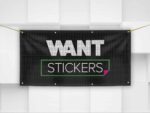
Follow our installation guide to properly install your reusable stickers for aluminum body vehicles. By adhering to our guide (see what we did there), you’ll be able to get the longest possible lifespan of your vehicle prints.
We recommend reading this full article to make sure you are preparing your surface correctly, but if you are ready to install you can skip to install method videos.
Clean Your Surface
It is important to only apply your reusable stickers to surfaces that have been cleaned before each application. Removing all dirt, oil, or moisture from the surface using Sprayaway cleaner (recommended), soap & water, mild cleaning solutions, or just a damp rag if absolutely nothing else is available. Make sure the surface is wiped and completely dry before application.
Please read our surface preparation article if you are not familiar with installing vinyl.

How To Position Your Print
There are a ton of ways to find the correct position and how to level or align with objects on your vehicle. We are not going to cover that in this article, because that is purely subjective. We do have an article that discusses positioning your print level to the ground or the contour of your vehicle if that is a concern.
Typically, professional installers will measure from an object in a couple of areas on a vehicle and place alignment markers with tape as registration.
Most commonly, door stickers and vehicle body stickers that are being reused and removed are just eyeballed during the installation. The installation is usually more of a function, not fashion. Since it is a repositionable sticker material, you can just remove it and start again if it doesn’t look right.
Installation Methods
There are many types of installation methods, but we’ve limited it to three for this product type. Feel free to implement any method that you may find in other resources on the internets.
The main thing with this product type is to preserve the backing liner paper that it is shipped with. All of these methods demonstrate the installation methods without cutting the liner paper. This is to keep the backing liner a solid piece that the sticker can be returned to if you choose to use that as your storage method.
If you plan on using the liner paper for storage, it is important to not crease the liner paper too much as shown in the quick thing method. Just a light fold-around will do, while you secure the hinge. This way the liner paper will still lay flat once you are ready to return the print to the liner paper. If you are not using the liner paper, there are some suggestions at the bottom of this article.
Quick Hinge
This is the easiest installation method. With a simple positioning and adhesive locking method, you’ll have your print installed in seconds.
Full Hinge
This is the most accurate method but does take a lot of prep and patience.
Freestyle
For very small prints this is pretty easy, but for large prints, it is a risky installation method, but if you know what you are doing it is the fastest method.
Click on tabs to view install method.
- Quick Hinge
- Full Hinge
- Freestyle
This method offers a quick and straightforward approach to installing a vinyl print. Essentially, you expose a section of the adhesive as you locate the correct (or close-to-correct) position. Once you’ve anchored your hinge in that initial spot, you can proceed with the installation until you reach the end. If the item is small, one person can install it alone. But for larger items, it’s a good idea to have a second person on hand. They can help hold the item in place while the other person sticks it on. If not, you will need to use tape to hold in place while you position your item.
These methods are for surfaces that are flat or with subtle curvature.
Quick Hinge Horizontal Item (Landscape)
In this video, you’ll see how to work with a wide, landscape-oriented object. This means it’s wider than it is tall, and you can apply it either from left to right or right to left, depending on which hand you prefer to use.
Quick Hinge Vertical Item (Portrait)
Use this method if your item has equal width and height dimensions, such as a perfect square or circle.
In this video, you’ll learn how to handle a tall, portrait-oriented object. This means it’s taller than it is wide, and you’ll be applying it from top to bottom.
After you’ve prepped your surface, here’s how to go about it: Start by peeling a small part of the vinyl away from its backing. Position it where you want it and create a hinge by sticking it to the surface near the edge of the liner. Once it’s securely in place, take your squeegee and start smoothing it out in the direction shown in the video. Make sure to angle the squeegee and work from the center towards the edges. Change the angle when you change direction. After you’ve tackled the first part, lift the liner from underneath and proceed to install the second section.
The hinge method, while not the fastest way to install, offers a more precise alternative to the quick hinge installation. You’ll need to use tape to secure sections and create a vertical or horizontal tape divider to act as a hinge. We’ll demonstrate this method, but in most cases, especially for repositionable print installations, it might be more than you need. In the video, we’ll be showing how a single person can install a small item. However, if you’re dealing with larger items, it’s advisable to have someone else around to help hold the item in place while you tape and squeegee.
These methods are for surfaces that are flat or with subtle curvature.
Full Hinge Horizontal Item (Landscape)
The video features the installation of a landscape-oriented item, which means it’s wider than it is tall. You can apply the item from left to right or right to left, depending on your dominant hand preference.
Full Hinge Vertical Item (Portrait)
Use this method if your item has equal width and height dimensions, such as a perfect square or circle.
In this video, you’ll learn how to handle a tall, portrait-oriented object. This means it’s taller than it is wide, and you’ll be applying it from top to bottom.
The basic idea here is to use tape to keep the print in position. First, secure it with a solid vertical piece of tape to create a hinge. Then, release a small section of the vinyl from the backing liner and lock it onto the surface near the liner’s edge. Once it’s in place, start squeegeeing in the direction shown in the video, angling the squeegee and working from the center to the edges. Change the squeegee angle for each direction. After you’ve installed the first section, grab the liner from underneath and continue with the second section.
Get ready, folks! This method might seem bold, but when executed correctly, it’s quick and efficient. Here’s the scoop: you peel off the entire backing liner and go in without any cover. Just keep in mind that it’s repositionable (unless you are using a super aggressive adhesive – on a high surface energy installation), so as long as your surface and hands are clean, you won’t mess up the adhesive. And remember, don’t let that sticky side make contact with itself. If you’re dealing with a big item, having an extra set of hands can be a lifesaver.
These methods are for surfaces that are flat or with subtle curvature.
Freestyle Horizontal Item (Landscape)
Freestyle Vertical Item (Portrait)
Use this method if your item has equal width and height dimensions, such as a perfect square or circle.
In this video, you’ll learn how to handle a tall, portrait-oriented object. This means it’s taller than it is wide, and you’ll be applying it from top to bottom.
Here’s how this method works: first, peel off the entire backing liner paper. Next, carefully place your item onto the surface. You can gently tack down the corners or other areas of a custom-shaped item. Once the vinyl is positioned close to the “glass” without any wrinkles, it’s time to set up your hinge. In the video, you’ll see a vertical locking hinge placed near the center. Then, start squeegeeing at an angle, moving from the center outward in the first section. Once the first section is applied, you can move on to the second section.
Other Variables
You’ll find some helpful topics related to this installation type below. Some of these are covered in our how long do reusable stickers last article.
Removal and Reinstallation
When removing you’ll want to make sure that you are pulling edges/corners as cleanly as possible. If you introduce dirt or oily hands at this point it may affect the adhesive upon the next installation. You may want to use a thin flat tool that can lift the corner first before grabbing it with your hands. This way your fingertips are not immediately adding contaminants to the adhesive.
Remove carefully to not stretch the material. Some stretch may occur when stuck to areas with high surface energy or installed for long periods of time. Even if there is a subtle stretch it should not affect the next application using proper installation techniques.
Slowly, start peeling/pulling from a corner. If it is a smaller print (~24″ x 24″) you can just peel the entire print away and prepare it for storage.
If you are working with a very large piece, you may need a second person to help hold the print at then end when it fully releases.
Storage
To store your print there are many options. The main thing is to preserve the life of the adhesive. The most common storage methods are:
- Temporary Surface Storage: Place it on a flat, clean, dry, and non-porous surface like painted drywall, a desk, or a laminated hard board. Avoid surfaces that collect dust, hair, have a rough texture or fibers. If the area has high humidity, fully apply the print to prevent dirt, dust, or moisture from affecting the adhesive.
- Original Backing Liner: Use the liner it was shipped with for storage. Lay the print flat or roll it up—rolling may cause slight tunneling, but this is fine for temporary storage. The liner that came with your print has a greater dimension than the print itself.
- General Storage Considerations: Store in any location that is free from dust and moisture to prevent adhesive contamination.
Squeegee or No Squeegee
This material is so nice to deal with. Unlike some very thin vinyl. You don’t need a squeegee like most vinyl materials, but can be used if you feel necessary. With proper methods, it can be applied flush to the surface without a squeegee. Just use the methods described above, by pushing the air from the center out with the edges/palm of your hand and you’ll have your print installed in minutes.











